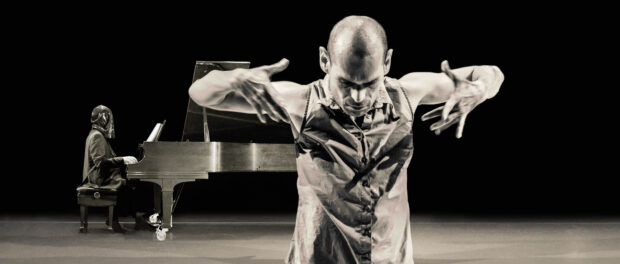José Navas’s Winterreise: A Cautionary Tale for Valentine’s Day?
Winter is long and hard. It sucks. Finding out that your significant other has ditched you for another and that you must leave your cozy home to wander, grieving and alone, forevermore, until you sink into oblivion and madness, in winter, really really sucks.
Seeing José Navas’s choreographic interpretation of Schubert’s 19th-century song cycle Winterreise (“Winter Journey”) puts those 55 cm of snow that fell on Montreal last week into perspective: it can always be worse. Unless of course you’re the person who just got dumped.
In his solo show, Navas explores various stages of solitude, alienation, and enlightenment that the newly solo wanderer traverses in his journey. It is, at times, profoundly moving. At other times, however, it left me a little cold, a little unmoved.
Navas works with live musicians on stage: Francis Perron on piano, with the tenor Jacques-Olivier Chartier. The live music, interpreted with great sensitivity, provides a perfect counterpoint to Navas’s dancing. It’s as if Navas and Chartier are performing a duet: Chartier explaining the events with words, Navas interpreting the emotional content of those words with his body.
Although sometimes I wished that the German texts of the 24 songs (written by Willhelm Müller) could have been translated and projected somehow, maybe as surtitles above the stage, I think Navas’s intention was to provide a translation directly into movement. We don’t, after all, necessarily need to know the words—if ever you’ve suffered a terrible breakup you can pretty much imagine them—and it’s cool to just see how that emotional experience animates a physical body. Take, for example, the several sections throughout the work where Navas enacts walking: at first in a determined, upright, relatively quick manner, then in an exaggerated, slowed down, bent-over way, and then, during the last two songs, in the manner of one who is doomed to walk, exhausted and alone, forever. The evolution of the simple act of walking communicates something at an emotional level beyond ambulating from point A to point B.
Another recurring theme is the use of fabric, often very sparkly, to cover Navas’s head, face, and sometimes upper body. According to the notes these parts of the choreography are meant to indicate periods of transition. I’m not sure that was accomplished, but the resulting facelessness and blindness does communicate something profound about loss.
At approximately the central moment of the 75-minute-long work Navas appears stark naked, lying on his back, squirming and seemingly unable to get up from a horizontal position, effectively portraying the sense of utter vulnerability one feels in such moments of emotional torment.
I find sometimes that Navas’s dance vocabulary is trapped in a netherworld between ballet and modern dance: full of arabesques and pliés and pointed toes, but fluid and improvisatory and gracefully off-kilter. I’m not sure why, but this doesn’t always work as well as his more internal, emotional, barely expressed movements. I also find that when his gestures match too closely with the piano music the effect is a little clumsy.
To tackle an enormous work like Winterreise as a solo is a monumental task. Although some individual moments were less emotionally charged, the effect of the whole was extremely moving. And perfectly a propos for this cold, bleak month, the specter of St. Valentine grinning at its center, Cupid poised to strike.






